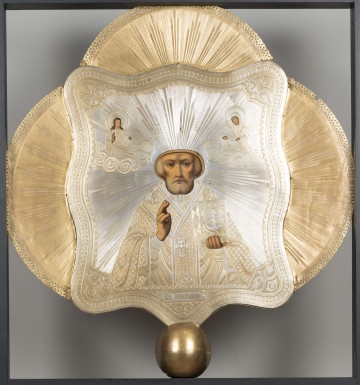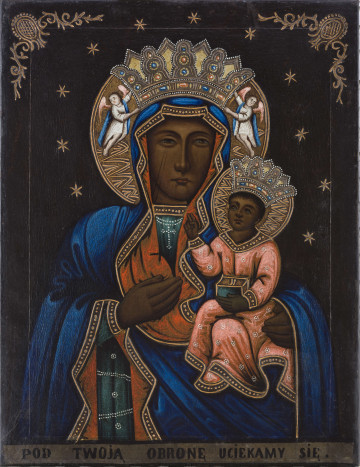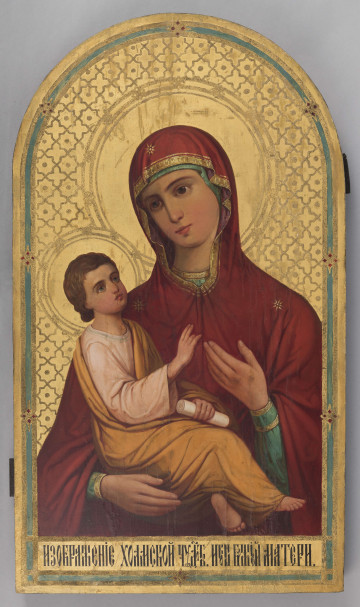
Mother of God of Kazan. Saint Nicholas
1890 — 1910
National Museum in Lublin
Part of the collection: Folk Art of the Lublin Region (17th–1st half of the 20th c.)
The Kazań icon of the Mother of God, famous for its miracles, is one of the most venerated Marian representations in Russia. It represents the iconographic type known as Hodegetria, i.e. the Guide or Wayfinder, to which the Madonna of Jasna Góra also belongs, an icon of Eastern Christian origin. In this icon, Christ, portrayed frontally, does not sit on his mother's hand, but stands on her lap, facing the praying people. The right hand of the Child is raised in a gesture of blessing, while the left is lowered and covered with a robe. The three interlocked fingers of Jesus' blessing hand point to the Holy Trinity, while the other two fingers depict the divine and human natures. Jesus' head is surrounded by a nimbus, as is Mary, whose head is inclined towards her son, as if she were saying something to him.
The Kazań icon was a support for the Russians during many historical storms. The first time was during the mentioned liberation of Kazan from the Tatars. Then in 1610-1612, during the Polish-Russian War, when Sigismund III wanted to seize the throne and introduce Roman Catholicism to Russia. It was then brought to Moscow. During the Napoleonic Wars, in 1812, it was again the main target of prayers of the defenders of Russia.
The story of the icon's wandering is almost unbelievable. From Kazań Cathedral of Annunciation at the beginning of 17th century it was first transferred to the basilica on Moscow Red Square, then to the Church of Presentation of Mother of God in Łubianka. In 1633 the icon was placed in the Moscow Kazań Cathedral. After making St. Petersburg the capital of the Russian Empire in 1712, Tsar Peter the Great ordered to transfer the miraculous icon to the new capital. Initially, it was located in the church on St. Basil's Island, then in the Holy Trinity Cathedral on the territory of St. Alexander Nevsky Lavra, and from 1727 to 1736 in the Church of the Nativity of the Mother of God on Nevsky Prospekt. In 1811 the built Kazan Cathedral was consecrated as its destination. The icon was stolen and disappeared in 1904. It appeared again in Great Britain and in the USA in the 1950s, in 1964, it even found its way to the World Exhibition in New York. Since 1970, it was in Fatima for several years, from where it was transferred to the Vatican in 1993. By order of Pope John Paul II, the icon was returned to the Russian Orthodox Church in 2004.
Author / creator
Dimensions
cały obiekt: height: 38,5 cm, width: 49 cm
Object type
picture
Technique
oil technique
Material
plank, oil-based paint
Creation time / dating
Creation / finding place
Owner
The National Museum in Lublin
Identification number
Location / status

1890 — 1910
National Museum in Lublin

1901 — 1920
National Museum in Lublin

1801 — 1900
National Museum in Lublin
DISCOVER this TOPIC
National Museum in Szczecin
DISCOVER this PATH
Educational path